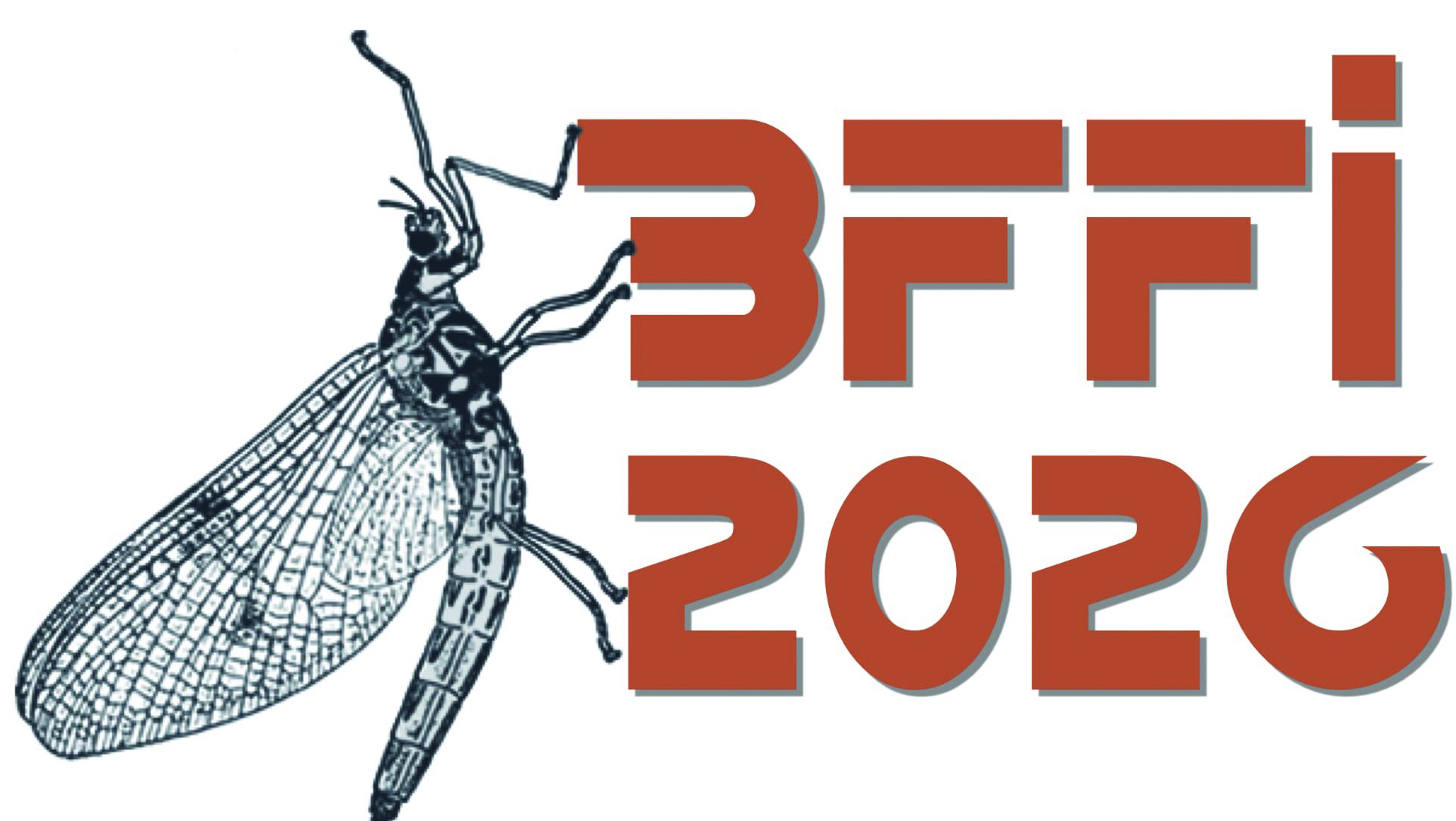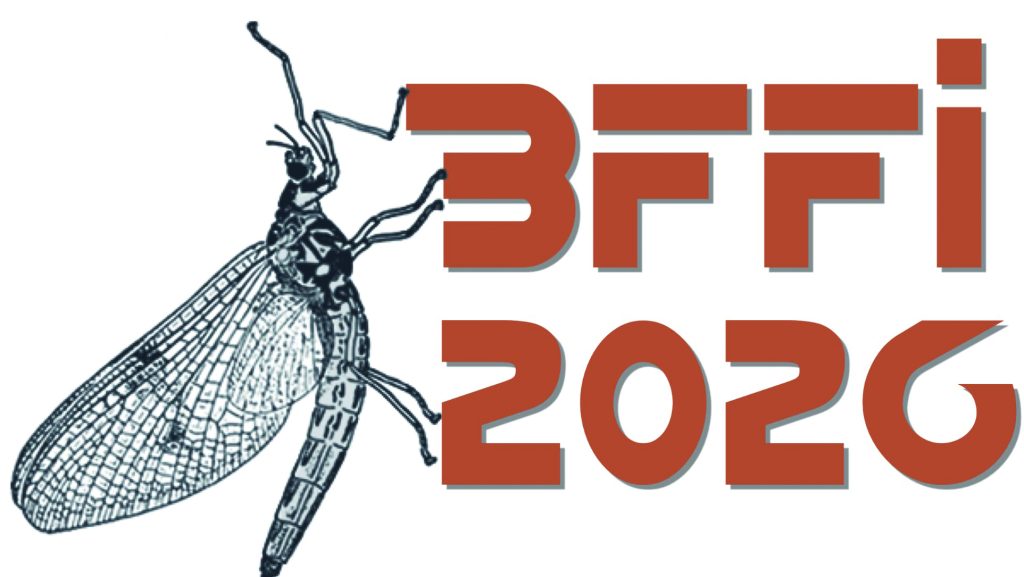AUTUMN FLY FISHING WITH BUZZERS, OLIVES AND FRY PATTERNS
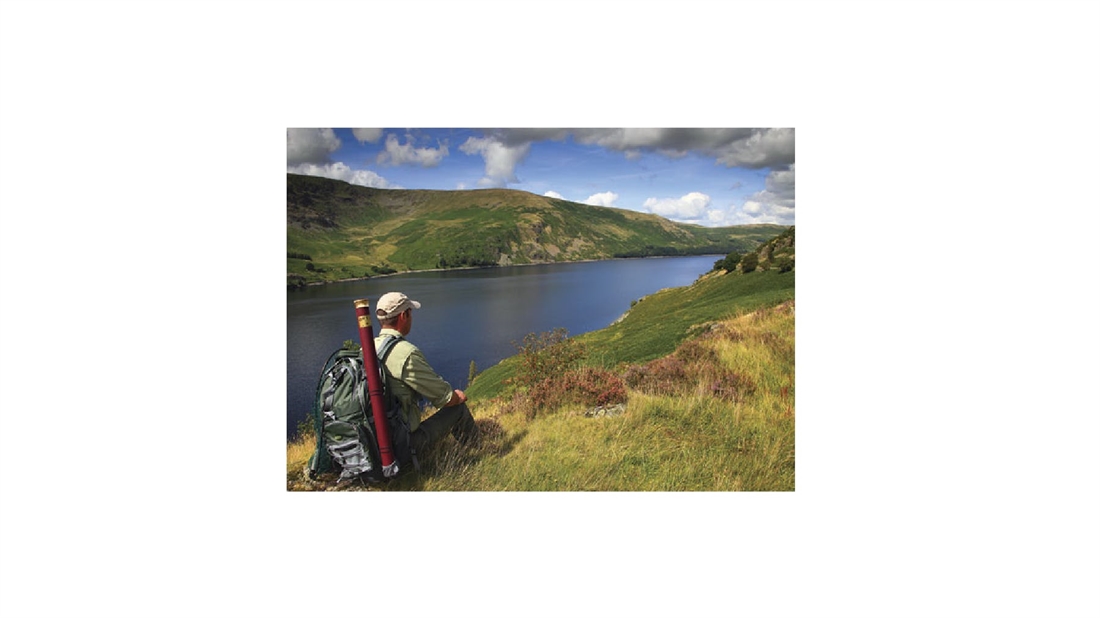
The cool breezes of autumn freshen the water and liven up those wild brown trout. These cooler conditions mean its time to fly fish with buzzers, olives and fry.
AS autumn takes hold, shorter days often see heavy overnight dew giving cooler, fresher conditions after dark and more risk of frost. This change curtails evening activity and, with hatches usually confined to the warmer parts of the day, sensing winter, trout generally feed in earnest now. Many insects that kept us going in spring make a second appearance now, but we cannot simply revert back to the tactics of early season.
Sociable hours
CHASING trout in the small hours of a sultry summer night is exciting stuff and, while you’ll often have the water to yourself, such a regime can be tiring, especially when a decent hatch stretches well into the night. Thankfully, late-season fishing usually centres around midday and, even when warmer conditions prolong insect activity, dusk occurs much earlier so there’s no danger of burning the candle at both ends.
Autumnal equinox
OCCURRING around September 22 the autumnal equinox sees day and night of equal length. Obviously, past this date, night becomes longer than day and we’re on the slippery slope to winter. This profound change can bring a particularly unsettled spell of weather with strong winds and sometimes gales persisting for days. Such winds stir up the water, cancelling out the thermal stratification (layering) of summer and introduce cooler more oxygenated conditions that favour trout. Shaking off their hot weather lethargy and feeling more rejuvenated, trout are often in chasing mood now. Being sensitive to their surroundings fish are aware that winter is just around the corner. With hard times ahead, such fish usually have an edge to their appetite.

Don’t get caught out
ALL too frequently, you’ll end up miles from your vehicle searching for wild trout. With topsy-turvy weather in the offing, carry appropriate waterproofs. Aside from a jacket and cap, waders help explore water and protect against foul weather. If walking a fair distance to a desired fishing area, bundle these into a haversack. Breathable waders are far more comfortable when covering lots of ground. Forget those with the bootfoot fitting. Although easier to pull on and take off, the boots behave more like Wellingtons, rattling round on your feet, making distance walking more arduous. Instead, the stocking foot type require a lace-up boot that fits snugly onto the foot and provides reinforcement, perfect when covering rocky terrain often found along the shores of wild waters.
Felt soles offer superior grip on slippery rock when in water, but can be unpredictable when walking on wet grass or exposed mud. Aquastealth soles are a better option though not quite as good on slimy rocks. Whichever you chose, refrain from inserting tungsten stubs. Although affording extra purchase on tricky surfaces they tend to be noisy, potentially alerting nearby trout.
Familiar favourites
AS discussed last month, some insects remain throughout the season, typically buzzers and the olive family. Autumn sees a resurgence of these flies as they have one last fling before winter arrives. Even with the threat of frost, come midday, buzzers and olives hatch in earnest. Given breezy conditions then we can revert to our trusty team of wets worked through the upper layers. Despite weather trends reminiscent of spring, water temperatures generally remain comfortable with trout holding in the upper layers. Obviously a floating line is a must with little call for a sinker.
Faced with zephyr like winds, dry flies or sparse nymphs will stay in touch with fish. Trout quietly sipping at the surface are a sure sign that buzzers are on the menu. Of course, fish taking terrestrials do so in a similar fashion, so always try to identify what fish are feeding on. A look at the windward shore (exposed bank) ascertains potential trout food. Here many nymphs, emergers and sometimes winged adults that didn’t make it are amongst the foam and flotsam. Generally, more splashy rises are trout moving at speed to seize their meal. Both sedges and to a lesser extent olives can be responsible for this. Although a summer fly, sedge hatches frequently stretch into September. Emerging sedges and olives are keen to fly off quickly and, aware that their potential meal may vanish, trout are close on their heels. The effects of such feeding behaviour are those exciting, healthy rise forms, often mistaken for trout hitting terrestrials at the surface.
Land-borne flies
LAND-BORNE insects are equally aware of the encroaching cold and they too seem eager to secure next season’s generation. Now, flying ants, black gnats and daddies can show in surprising numbers. In particular, ants and gnats often occur close to water, providing trout with a back-end beanfeast.
Ants sprout wings before taking to the air. Usually the first sign that anything is afoot will be gulls wheeling overhead. Late afternoon and early evening when the day is warmest often sees the best of ant activity and, as the breeze dies away, many naturals litter the surface. Trout homing in on ants rarely have eyes for anything else. So be sure to have an imitation. That said, I’ve been caught out before, yet still managed to tempt fish with small black Klinkhamers or Black Gnat dry flies.
Black gnats can appear in hordes during autumn though their small size means they may go unnoticed. Unless it’s calm, gnats have a habit of becoming almost waterlogged, rendering them low-riding in the surface film. Tired and weak, gnats become easy pickings for trout, which need not expend too much energy. Barely creating any disturbance, it’s natural to assume trout are harvesting emerging buzzer pupae. Again, check the margins or nearby meadows and shrubs for signs of winged adults. Usually, these cling to cover and only venture further in light breezes when you see clouds of them in the open. Usually the early part of a fall sees increased activity close to the lee shore (sheltered bank). But, any appreciable breeze quickly conveys gnats and other terrestrials across the surface to the exposed windward bank.
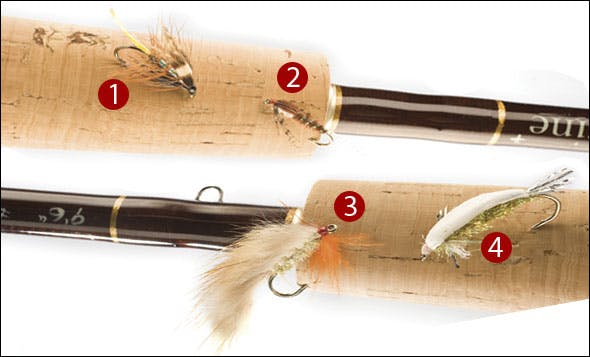
1. Pearly Invicta
Hook: Size 10-12 Kamasan B170 Thread:Black 14/0 Sheer Rib:Silver wire Tail:Golden pheasant crest Body:Pearly tinsel Hackle:Ginger cock hackle, palmered Wing:Hen pheasant tail Throat Hackle:Blue jay
Often overlooked, traditional wets certainly have a place when it comes to tempting trout feeding on small fish and the Pearly Invicta fits this bill nicely. Although the original Invicta calls for hen pheasant tail fibres, hen pheasant secondaries are a lot easier to work with.
2. Pearly PTN
Hook: Size 10-14 Fulling Mill All-purpose Thread: Orange 14/0 Sheer Rib: Pearly tinsel Tail: Orvis crystal flash, pearl Body and Thorax Cover: Cock pheasant tail fibres Thorax: Veniard’s pearly Glister dubbing Legs: Brown partridge Head: Wapsi fluo orange thread
Nymphs dressed slender with a touch of sparkle are more than adequate imitations of pinfry or small minnows. While this pattern is tied using cock pheasant tail, fibres from the hen bird make a nice alternative.
3. Minkie
Hook: Size 8-14 2x longshank Thread: Danville’s 8/0 red Body: Olive Ice Dub Tail and Back: Weasel zonker strip Throat: Orange marabou Head: Red thread
Although using a weasel strip, this pattern falls loosely under the ‘Minkie’ heading. Generally, shorter in hair length, weasel lends itself to smaller flies for imitating minnows and sticklebacks. Various shades of Ice dubbing can be applied with olive, tan and pale yellow popular.
4. Floating Fry
Hook: Size 8-12 2x longshank Thread: White 6/0 Tail and Fins: Pearl flashabou or similar Body: Olive or tan ice chenille Back: Ethafoam
To fully appreciate this tying, it needs viewing from below. Olive and tan body colours are more in keeping with sticklebacks, minnows and infant perch that are the principal prey for many wild trout. White ethafoam is for our benefit, hopefully, making a low-riding fly that bit more visible.
Fry time
ALTHOUGH our lowland reservoirs steal the headlines at fry time, lakes and tarns are of interest to us now. Despite their apparent lack of richness to support vast shoals of coarse fish, many natural fisheries hold minnows and stickleback that provide a protein packed meal for trout. Even on more barren waters and hill tarns, it’s common to find a thriving population of minnows in the shallows. And while such baitfish are potentially on the menu all season, activity heightens in autumn when trout pack on weight for winter.
With weighty specimens filling the pages of Trout Fishermen at fry time, it’s natural to think that only large trout predate on small fish. Granted, huge fish are far more capable of dealing with large food items. But smaller trout are able to tackle some pretty substantial fish too. I once extracted a seven-inch trout from the throat of a 13- inch wild brownie, so minnows are more than fair game!
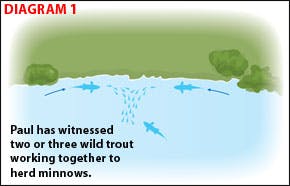
Weed beds and marginal boulders (evident on many glacial lakes) provide shelter for minnow shoals and any coarse fry (typically perch) that care to frequent these waters. Shallow regions too hold their share of minnows, as it’s here they feel safest. However, marauding trout, which use speed and guile to secure a meal, are never far away. Ever watchful, they wait for an opportune moment to strike. Charging full throttle into an unsuspecting shoal their aim is to stun or injure small fish. While such explosive strikes are indicative of ‘fry feeders’, there are times when trout feed on baitfish tactfully.
I’ve witnessed wild trout herding minnows in a shallow corner. These trout went almost undetected, my elevated vantage point gave a privileged view. On one occasion three trout clinically shepherded a shoal of minnows into a tight ball. With nervous minnows hugging the shoreline, two trout approached the shoal (one at either end) to drive them into the path of a third waiting trout (Diagram 1). Unaware of the presence of this third trout the fry were deftly pounced upon in slightly deeper water. Creating virtually no disturbance, there was little evidence of this act at the surface. Conversely, a single trout preying on baitfish stands a better chance by pushing them against the shoreline (Diagram 2). Now with one less escape route the shoal become confused. Performing evasive leaps and skipping away from attacking trout results in a dramatic commotion.
Although there’s every chance of experiencing ‘fry bashing’ on wild waters, it would be foolish to become solely reliant on this method. Like trout, we have to remain opportunists and constantly revise our tactics. That said, searching with fry patterns can be extremely productive. I break my approach into two distinct camps. While both methods are in essence a compromise, they’ve served me well through late season.
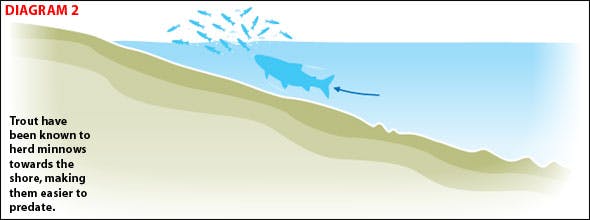
The first involves a standard three-fly set-up, with the floating line. More breezy conditions may call for an intermediate. Look to flashy patterns that suggest small fish. A typical team might be a Pearly Wickhams on the top dropper, Silver Invicta on the middle with a Zonker on the point. The Invicta makes a good corixa imitation too, which has worth during late summer. In fact, trout hunting corixa in shallow water often home in on their prey creating a distinct bow-wave – commonly mistaken for fry feeding behaviour. Thankfully, this doesn’t always matter, as opportunistic trout will eagerly snap them up, making this the ideal set-up for exploring the shallows.
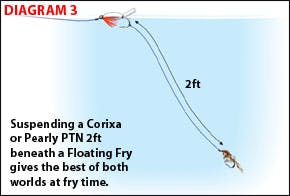
Experiencing that arm-wrenching pull from a chasing fish is exciting stuff, yet there’s more subtle ways to fool fry-feeding trout. Sick or injured fish often loiter near the surface, making them vulnerable. Trout are in no hurry to seize such an easy meal. They glide up and pluck them from the surface. Now we can present floating patterns in the surface film. While static or partially submerged flies usually do the trick, try hedging you bets with the New Zealand style (duo). Suspending a Corixa or Pearly PTN two feet beneath a Floating Fry improves your odds and on its day is lethal (Diagram 3). Finally, it’s too easy to think “the bigger the better” when it comes to fry patterns. Small, unassuming dressings on size 12-14 hooks can have just as much impact!

